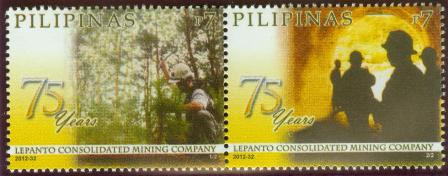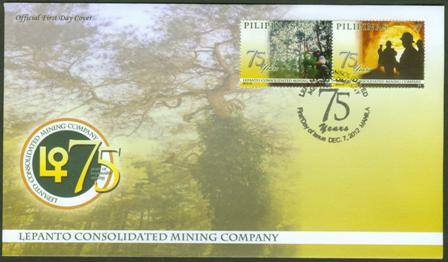2012, December 7. Lepanto Consolidated Mining Corporation - 75th Anniversary
Litho Offset. Amstar Company, Inc. Perf 14
Se-tenant Pairs, Sheets of 40

Se-tenant Pairs (55,500)
7p Reforestation
7p Underground Mining
Design Coordinator: Linda P. Castillo, LCMC
Layout Artist: Victorino Serevo
First Day Covers: Manila

LEPANTO CONSOLIDATED MINING CORPORATION - 75th ANNIVERSARY
Lepanto Consolidated Mining Company was established in 1936. The year 2011 marks the company's 75th anniversary in the business.
Lepanto is a Filipino primary gold producer. The Lepanto mines are located in Mankayan, Benguet where the Company has about a thousand employees.Copper mining was known to have taken place at Lepanto as early as the Ming Dynasty. Chinese traders at that time exchanged their wares for copper ingots.
When the Spanish conquistadores arrived in the 16th century, the natives attracted their attention to the extensive use of copper. However, hostile natives kept the district blockaded for many years. The opposition to the Spaniards was very much like their encounter with the Ottoman Turks in the "Battle of Lepanto" in 1571; thus, the Spaniards named the place Lepanto.
The Cantabro-Filipino Company under the direction of Don Jose Maria Santos started exploiting the copper deposits from 1864 to 1874. When he died a year later, the Spanish operation ceased.
At the turn of the 19th century, the Americans started prospecting in the Lepanto area. Various prospectors pooled their holdings and in September 1936, the Lepanto Consolidated Mining Company was born.
During the Second World War, the Mitsui Company of Japan operated the mine at a rate twice the pre-war capacity. After the war, the underground mine and mill facilities were rehabilitated and operations resumed in 1947.
The copper concentrate produced were shipped exclusively to ASARCO's Tacoma smelter, then the only smelter in the world that could handle Lepanto's concentrate which contained arsenic.
To access the lower levels of the Enargite Mine, the Tubo Shaft Project was undertaken and was completed in November 1977 by an all-Filipino crew. The Tubo Shaft significantly increased the life of the mine and the ore grade and improved ventilation in the working areas.
Anticipating the closure of the ASARCO smelter in 1985, the Company built a 50,000-t/a Roaster Plant in 1982, designed to reduce the arsenic content of the copper concentrate. Since PASAR was going to buy most of the roasted copper concentrate, called Calcine, the Roaster was built next to the PASAR facilities in Isabel, Leyte.
Marketing problems associated with the arsenic content of the copper concentrate and the declining copper price made copper operations very challenging in 1995 and 1996. The discovery of the Victoria in 1995 was therefore very timely, prompting Lepanto to immediately develop the orebody and prepare for gold operations.
During the period 1948 to 1996, the Enargite operations produced 1.58 billion pounds of copper, 2.9 million oz of gold and 12.0 million oz of silver, recovered from 34.4 Mt of ore averaging 2.2% Cu and 3.5 g/t Au.
When the Victoria deposit was discovered in September 1995, the exploration and mine development work shifted from the Enargite deposit to the Victoria. In preparation for the milling of the gold ore, the copper flotation circuit was shut down on January 31, 1997. The new P135 million (US$5 M) 2500-t/d carbon-in-pulp or CIP plant was commissioned on March 16, 1997.
During the first three years of gold operations, the Victoria was accessed through the same infrastructures utilized for the old Enargite mine, principally the Tubo Shaft. To provide easier access to the Victoria and improve ventilation, the Nayak Twin Decline project was started in July 1998. Two declines stretching 1 kilometer from the surface to the 1150L and an internal shaft were constructed in the Nayak Area. The project was completed in April 2000 at a cost of P675 million (M$15.0).
In 2000, a state-of-the art flotation circuit was built at a cost of P125 million (US$3.0 M) to handle the high-copper gold ore. The plant was commissioned in May and commercial production started in June 2000. After a year of operations and due to the very low copper price then, copper operations were once again suspended in late 2001. Copper operations resumed in 2007 as copper prices improved.
After ten years of operation, the Victoria had produced about 1.17 million oz. gold as of the end of 2007.http://www.lepantomining.com/index.html
-
Business / Commerce